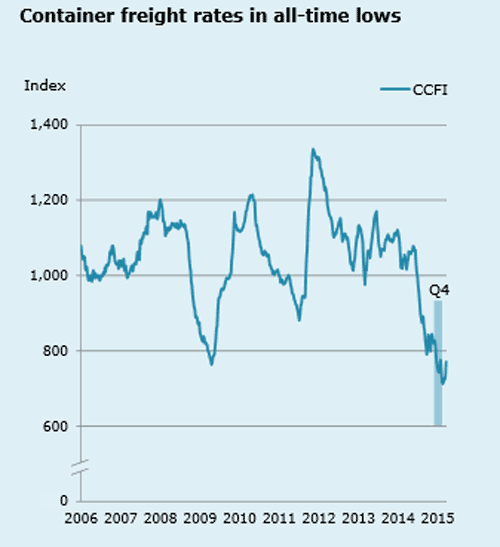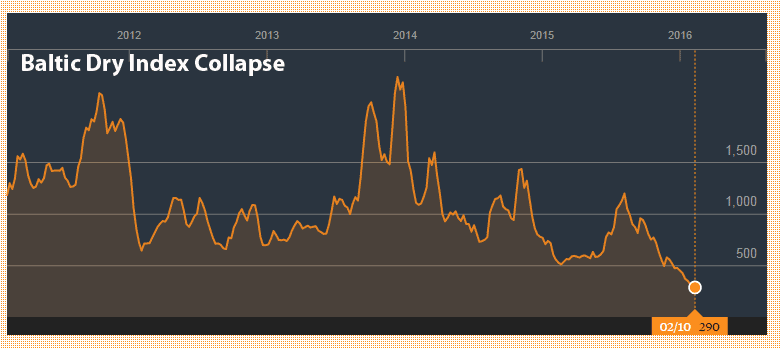The Collapse in Input Prices - What Does It Mean?
We are living in some very strange economic times.
We could start with the "new normal" of lukewarm growth (2% or so) seemingly every year in the US, and barely positive growth if that in Europe. Nothing seems to change that trajectory.
We could start with the "new normal" of lukewarm growth (2% or so) seemingly every year in the US, and barely positive growth if that in Europe. Nothing seems to change that trajectory.
|
But that said, it seems like decent enough economic environment for most - so why is the price of everything collapsing?
I am going to let charts do most of the talking here, so let's start with oil. We all know the general story: oil was actually very steady in the $90-100 per barrel from 2011 through the first half of 2014, and then pow - a 70% or so drop to around $30 now for about three months. And of course, that is down 80% from $140 or so we saw in July of 2008. Chart here.
Diesel prices have followed suit, recently dropping below $2.00 per gallon for the first time since 2005. Where I am located in Ohio this week diesel was below gasoline prices per gallon - can't remember the last time that happened.
Diesel prices have followed suit, recently dropping below $2.00 per gallon for the first time since 2005. Where I am located in Ohio this week diesel was below gasoline prices per gallon - can't remember the last time that happened.
The same basic story for natural gas, where generally the price is lower in the US than most of the rest of the world. As you can see in this chart, natural gas prices have fallen from $6.61 per million BTUs in 2011 to about $1.75 currently - a decline of an astounding 74%.
Other commodities of all types are in retreat. The IHS Materials Price Index - which tracks a basket of commodities - is down about 60% just since July 2014, as shown below, and is now down past levels seen at the bottom of the Great Recession in 2009 to even lower 2003 levels - and yet we are not in a Great Recession.

As just a couple of examples of this outside of energy, you probably have heard of the collapse of steel prices, which have fallen by two-thirds since the $600 per ton level reached in early 2011 to about $200 today, as you can see here. Brutal. In June of 2008, the price was about $1265 - an amazing six times today's prices.
I don't have a chart, but many agricultural prices are also in the toilet. For example, wheat was $361 per metric ton in late 2012. It is now down more about 55% since then, at $164. It saw its all-time high of $439 in June of 2008 - nearly three times the current price.
Most of us know container shipping rates have also cratered, reaching modern all-time lows late in 2015, below variable costs to operate a ship and down by about 50% from 2012 levels, as you can see in the chart here that tracks the China Containerized Freight Index.

But perhaps the most astounding price story of all are the rates for bulk shipping of commodities, as is reflected in something called the Baltic Dry Index. In December 2013, that Index stood at 2330; it was at 290 this week- an almost unimaginable 88% decline.

What the hell is happening? Other things of course have held up - trucking and rail rates, for example, and thankfully wages for the most part.
But all this is wreaking much havoc, even if sometimes that pain is out of direct view. Oil-focused countries - most notably Russia - are facing economic disaster, and who knows what that will lead to. Commodity-dependent Canada quietly went into recession last year, and Brazil's economy is a mess. The whole US oil-natural gas fracking sector is in jeopardy - the growth of which had been a key factor in reaching just the modest 2% GDP growth we've seen in recent years.
The container shipping industry is madly consolidating. Bulk container lines are selling any asset they can just to "stay afloat" financially.
Steel giant ArcelorMittal lost $7.9 billion in 2015. Steel companies around the globe have been rapidly shedding workers. Steel sector employees - blue collar, managers, executives - just recently staged a mass march in Brussels to protest low cost Chinese imports they blame for the price collapse.
An article last week in the Farm Journal was headlined "Dilemma for U.S. Farmers: Which Crop Will Lose the Least Money?" Meanwhile, mining and agriculture woes are taking down great equipment companies like Caterpillar and Deere.
There are myriad and varying factors in all this, from a slowdown in Chinese demand (number one source of blame for most observers) to a strong US dollar to insane capacity growth in the shipping industry, etc.
But for the years before mid-2008, the corporate concern was on ever rising "input and logistics costs," often blamed for missing earnings targets.
Now, this scenario is simply turned on its head - and again, all this in decent economic times. What will happen if we do slide into recession? Could it get even uglier?
While lower gas costs are great for consumers, and lower input costs great for some (but certainly not all) businesses, I have to wonder if the markets - with prices worse than the bottom of the Great Recession - aren't telling us that an economic slowdown is indeed coming.
Maybe it is just supply and dermand at its most brutal, but we've never seen prices collapse like this in relatively good economic conditions in our lifetimes.

No comments:
Post a Comment